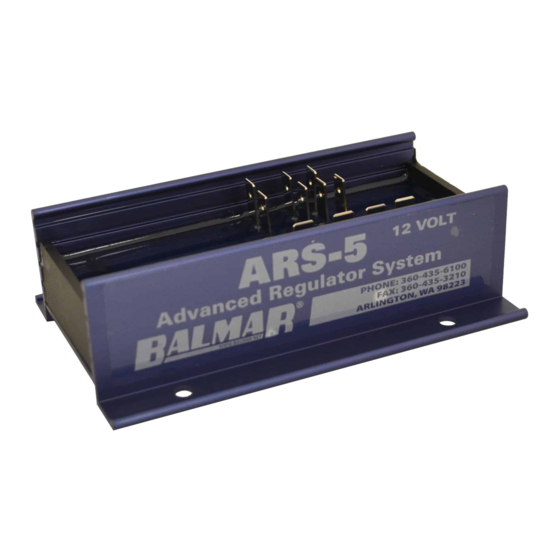Balmar ARS-5 Panduan Instalasi dan Pengoperasian - Halaman 15
Jelajahi secara online atau unduh pdf Panduan Instalasi dan Pengoperasian untuk Pengontrol Balmar ARS-5. Balmar ARS-5 16 halaman. Multi-stage voltage regulator
Juga untuk Balmar ARS-5: Panduan Instalasi dan Pengoperasian (20 halaman), Panduan Memulai Cepat (2 halaman)

If voltage is not present on the RED, the BROWN and the Positive Battery Sense Wire, the regulator will not work. If volt-
age is as expected at the RED the BROWN and Positive Battery Sense wire, and there is zero, or an unexpected voltage
reading at the BLUE wire, contact our technical support staff at (360) 435-6100, or e-mail us at [email protected].
If all voltages at the regulator meet expectations, yet the alternator is not producing charging current, test the alternator.
The following tests are recommended for determining alternator functionality.
Alternator Testing
TEST #1- The following test is used to isolate the alternator and determine if the failure is a result of the alternator. Once
again, testing at either the alternator or regulator is only effective if the wiring, fusing and batteries have been determined
to be in correct working order. The alternator and regulator can be tested for function by determining if a magnetic field
exists at the alternator's pulley shaft or rear bearing. To test:
•
With the ignition in the OFF position, place the tip of a non-magnetic steel screwdriver near the nut on the pul-
ley shaft or near the rear bearing of the alternator. There should be no evidence of a magnetic field pulling the
screwdriver toward the alternator. (A slight amount of magnetism may be present, due to residual voltage in the
alternator.)
•
Engage the ignition, without starting the engine, to activate the voltage regulator. If an oil pressure switch is used,
a jumper between the RED and BROWN wires in the Ford-style plug will activate the regulator.
•
After allowing time for the regulator's start-up delay, place the head of a steel screwdriver near the nut on the
pulleyshaft or near the rear bearing of the alternator. There should be substantial magnetic pull. If a magnetic
field is present, the voltage regulator, alternator brushes and rotor are likely to be working properly.
If there is little or no magnetic pull at the pulley shaft or at the rear bearing, initiate the following test:
With the key off and the engine off, remove the large harness plug from the regulator.
•
Insert the end of a short length of electrical wire to the RED connector slot of the regulator harness and the other
end of the wire to the BLUE connector slot. This bypasses the regulator and tests the alternator and the har-
ness.
•
Using your steel screwdriver, inspect for a magnetic field as described above.
•
With your voltmeter, check for voltage on the blue wire at the alternator. If voltage does not exist, the harness may
be at fault. If voltage does exist at the harness, but no magnetism is pres-
ent, the alternator is likely to be malfunctioning.
•
If a magnetic field is present. Both harness and alternator brushes and ro-
tor appear to be working properly. If no magnetic field is present, proceed
with the next test.
Testing the actual output of the alternator is known as "Full Field Testing". This can
be accomplished by jumping a positive 12VDC current to the field terminal at the
rear of the alternator. This test eliminates both the regulator and the harness, mak-
ing it easier to isolate your investigation to the alternator.
CAUTION: Ensure that all voltage sensitive equipment is turned off prior to start-
ing the engine. Voltage is unregulated during this test and could damage sensitive
electronics. DO NOT let the engine run any longer than necessary to detect charg-
ing. If the system is not charging, remove the alternator and have it inspected by a
qualified alternator shop, or call Balmar for warranty evaluation.
To test the alternator:
•
Clip a jumper wire to the positive post of the alternator, or on the battery side of the isolator (if an isolator is in
use). Use a SHIELDED alligator clip for post attachment. Unintentional contact between the alligator clip and the
alternator case could result in damage to your electrical system.
•
Disconnect the field wire from the rear of the alternator and attach the other end of the jumper wire to the alterna-
tor's Field terminal (F). CAUTION: Do not allow the wire to contact the case while it is attached to the positive post.
The case is grounded and severe damage could occur.
- 15 -
